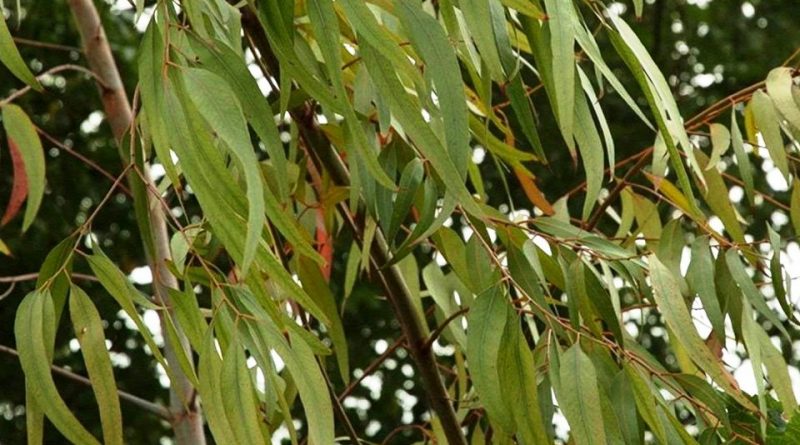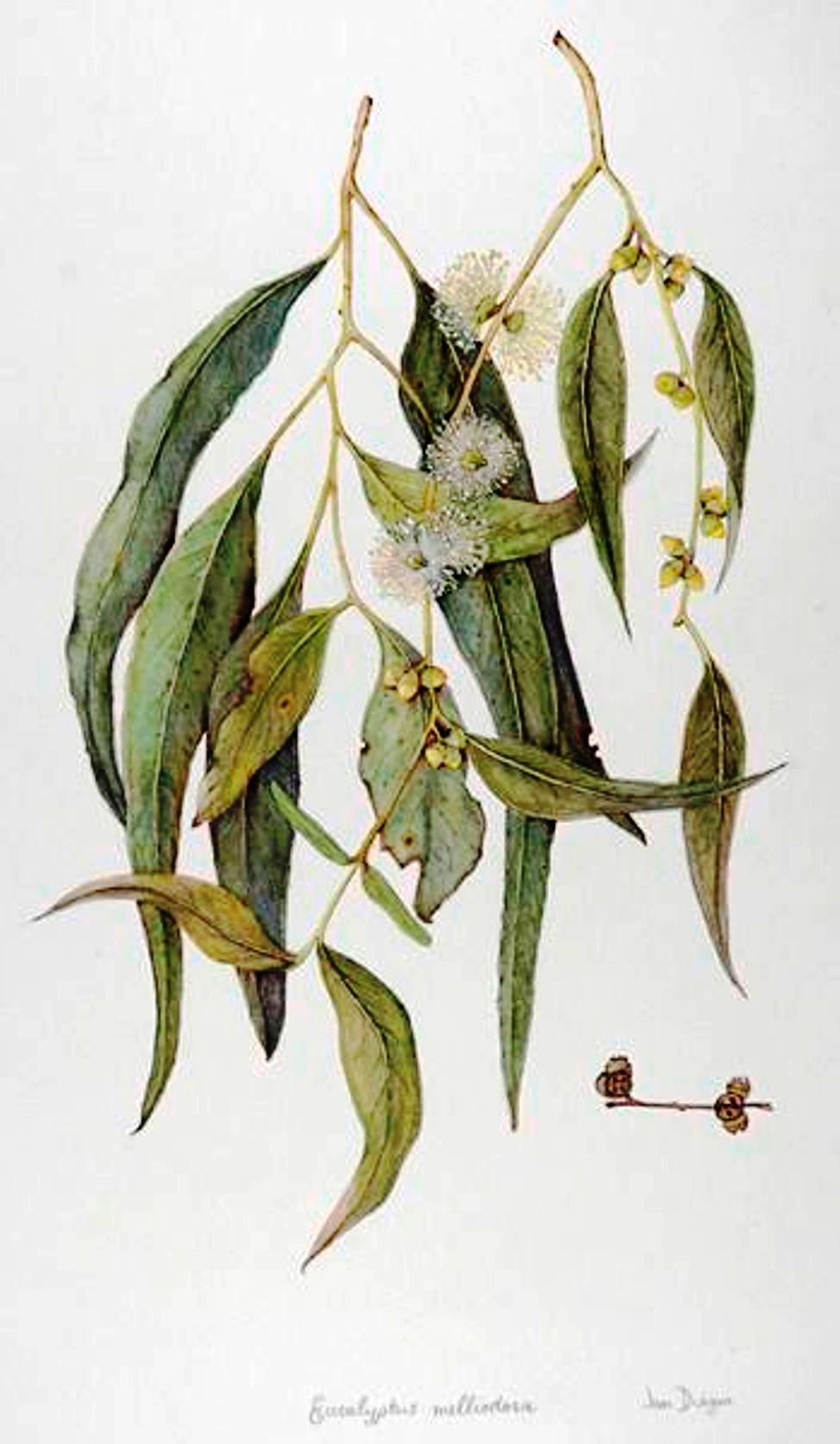Corymbia citriodora
Corymbia citriodora
Lemon-scented gum (Corymbia citriodora (Hook.) K.D.Hill & L.A.S. Johnson) is an arboreal species belonging to the Mirtaceae family.
Systematics –
From a systematic point of view it belongs to:
Eukaryota Domain,
Kingdom Plantae,
Magnoliophyta Division,
Magnoliopsida class,
Order Myrtales,
Myrtaceae family,
Genus Corymbia,
Species C. citriodora.
The terms are synonymous:
– Corymbia citriodora (Hook.) KDHill & L.A.S. Johnson subsp. citriodora;
– Corymbia citriodora subsp. variegata (F.Muell.) ARBean & MW Mc Donald;
– Corymbia variegata (F. Muell.) KDHill & L.A.S. Johnson;
– Eucalyptus citriodora Hook .;
– Eucalyptus maculata var. citriodora F.M. Bailey nom. illeg .;
– Eucalyptus maculata var. citriodora Kinney nom. inval., nom. nud .;
– Eucalyptus maculata var. citriodora (Hook.) FM Bailey;
– Eucalyptus melissiodora Lindl .;
– Eucalyptus variegata F. Muell .;
Etymology –
The term Corymbia comes from the Greek κόρυμβος córymbos (in Latin corymbus), because its flowers are grouped in corymbs.
The specific citriodora epithet comes from citrus cedar, lemon and fragrant, fragrant odorus: with flowers or leaves that smell of citrus.
Geographic Distribution and Habitat –
Lemon-scented gum is a plant native to Queensland, Australia and is widely planted as an ornamental tree in many regions of the world for commercial purposes such as South America (mainly Brazil), China, India, Sri Lanka, Central America, West Indies and in most southern African countries. In Southeast Asia it is grown mainly in Peninsular Malaysia, Thailand and Vietnam.
Its habitat is that of lighter, slightly acidic clay soils and is found in dry sclerophyllous forests and in the woods of hilly countries although it succeeds on deep sandy clays in coastal regions.
Description –
Corymbia citriodora is a tree that, especially in the places of origin, grows up to a height of 25 – 40 m and sometimes up to 50 m.
It has a smooth, clear, uniform or slightly mottled, white to pink or coppery bark that spreads in fine flakes.
The young leaves have oval lancey shape, 80 – 210 mm long and 32–80 mm wide. Adult leaves have the same shade of glossy green on both sides, often smelling of lemon when crushed, from narrow lance-shaped or curved, 100-230mm long and 6-28mm wide that taper to a stalk 10–25 mm long. The white flowers are borne in the axils of the leaves on a 3 – 10 mm long branched peduncle, each branch bears three buds on 1 – 6 mm long peduncles.
The mature buds are oval or pear-shaped, 6-10 mm long and 5-7 mm wide with a rounded, conical or slightly beaked operculum.
The flowering period occurs in most months.
The fruit is a woody capsule in the shape of an urn or barrel 8 – 15 mm long and 7 – 12 mm wide with the valves enclosed in the fruit.
Cultivation –
Lemon-scented gum is a tree that grows well in tropical and subtropical areas, from arid to semi-arid, preferably in areas where rainfall, especially in the summer, is between 600 and 1,300 mm, with a dry season of 5-7 months.
The plant resists high temperatures (29 – 35 ° C maximum monthly average) and light frosts.
It prefers a sunny position in moderately fertile soil, tending to a neutral pH, well drained and which retains moisture. It tolerates poor and dry soils, especially those poor in mineral elements. This plant can be grown in poorly fertile clays, laterites, poor and gravelly soils and podzol, preferably well drained.
Preserved plants tolerate drought but cannot stand frozen cavities or windy sites.
Corymbia citriodora is a very fast-growing species. Flowering usually begins within 2 years of sowing and seeds are produced in abundance by 5 years of age.
When these plants are grown for biofuels yields of 10-21 cubic meters per hectare per year have been achieved.
Eucalyptus species do not have a deciduous habit and continue to grow until it is too cold to do so. This makes them more susceptible to damage from sudden colds. If temperature changes are more gradual, such as in a forest, the plants have the opportunity to stop growing and go dormant, thus making them more resistant to cold.
To prevent the soil from freezing, deep mulch around the roots can be used to help trees survive the cold.
If the plant is grown in warm temperate zones, especially to derive its essential oil, it thrives well in a Mediterranean climate.
From an ecological point of view, eucalyptus monocultures are an environmental disaster, as they are dewatering plants, allelopathic and poorly suited to preserving soil fertility.
The plants have shallow roots and, especially in windy areas, they should be planted in their permanent locations when they are small to ensure they do not suffer from crisis after transplant.
They are strongly affected by transplanting and should be grown in containers before planting them in their permanent position.
Propagation can take place by seed which should be sown on the surface in a container in a sunny position avoiding letting the soil dry.
Species that come from high altitudes appreciate the cold stratification of 6 – 8 weeks at 2 ° C. Germination rates vary but are usually 30-50% on average. Rapid and complete germination is obtained in conditions of humid heat (in the laboratory the temperature of 25 – 30 ° C proves to be optimal) in the presence of light.
The seeds of this species are relatively large, compared to other eucalyptus trees, and can be sown directly without pre-treatment in containers filled with a very draining, sterilized mixture of soil and sand and covered with a light dusting of fine sand.
Transplanting is recommended when the seedlings reach a height of about 25 cm, about 10-12 weeks after sowing. This should coincide with the beginning of the rainy season in tropical countries. The seed has a long vitality.
The flowers are rich in nectar and are a good source for bees.
The leaves are strongly lemon-scented when crushed.
Today it is grown in various countries.
Customs and Traditions –
On this species one must emphasize that many naturalists do not recognize the genus Corymbia, so they classify it within the genus Eucalyptus.
Molecular research in the 1990s, however, showed that they, that the genus Corymbia is more closely related to Angophora than to Eucalyptus, and probably should be considered as a separate genus. All three genera: Angophora, Corymbia and Eucalyptus, are not only closely related but often difficult to distinguish and are still commonly and correctly referred to as “eucalyptus”.
The leaves of this plant are used to produce herbal liqueurs. Like other species of mirtaceae, it has antiseptic properties for the respiratory system. It is used by the perfume industry, pharmaceutical and soap.
The essential oil has a lemon scent that is mainly made up of citronellal (80%); this is mainly produced in Brazil and China.
The unrefined oil of this plant is used in perfumery and a refined form of this oil is used in insect repellents, especially against mosquitoes. The citronellal content of the refined oil is transformed into the cis and trans isomers of p-menthane-3,8-diol (PMD), a process that occurs naturally as eucalyptus leaves age. This refined oil is widely known by its registered trade name, “Citrepel” or “Citriodiol”, but also by generic names that vary by region: “eucalyptus lemon oil” or “OLE” (United States of America) ; “Botanical oil rich in PMD” or “PMDRBO” (Europe); “PMD and related oil of lemon eucalyptus compounds” (Canada); Eucalyptus lemon extract (Australia). Pure PMD is synthesized for commercial production from synthetic citronellal.
The refined essential oil from Corymbia citriodora leaves can contain up to 98% lemongrass content. The smell of the essential oil can vary, but mainly includes a strong odor comparable alone to lemongrass oil, with a slight hint of lemon scent.
A study comparing mosquito repellents found that products using eucalyptus lemon oil were effective in keeping mosquitoes away from the skin of humans.
Corymbia citriodora also produces a sweet manna-like substance that is scraped off the leaves and eaten. The flowers also produce a uni floral honey.
Eucalyptus leaves are a traditional aboriginal herbal remedy. The essential oil contained in the leaves is a powerful antiseptic and is used worldwide to relieve coughs and colds, sore throats and other infections. An essential oil obtained from the leaves is antibacterial. The essential oil obtained from various species of eucalyptus is a very powerful antiseptic, especially when it is old, because ozone is formed in it by exposure to air. It has a decisive disinfectant action, destroying microbial life forms. The oil can be used externally, applied to cuts, skin infections, etc. It can also be inhaled for the treatment of blocked nasal passages; it can be used for gargle against sore throat and taken internally for a wide range of ailments. However, caution is advised because, like all essential oils, it can have a deleterious effect on the body at higher doses.
Other uses include biomass and biofuels, charcoal, firewood.
Among the environmental ones there are ornamental ones, land reclamation, revegetation, shade and shelter, windbreak.
The bark can contain up to 12% tannin. The heartwood ranges from light gray-brown to dark brown; it is delimited by a band up to 60 mm wide of white or cream sapwood. The wood is hard, strong and consistent. Saws easily, flattens well, but is rather difficult to nail and tends to control and collapse when drying. Wood is susceptible to attack by salt and termites. It is used for general and heavy construction such as frame and bridge construction, flooring, siding, tool handles, and case manufacturing.
Preparation Mode –
Corymbia citriodora is a plant of which practically everything is used. It also produces a sweet manna-like substance that is scraped off the leaves and eaten. From the flowers is obtained, moreover, a uni floral honey.
The oleoresin that oozes from the tree can also be obtained by making incisions in the trunk. This resin contains tannin and is powerfully astringent; it is used internally in the treatment of diarrhea and bladder inflammation and externally applied on cuts, wounds, etc.
Guido Bissanti
Sources
– Acta Plantarum – Flora of the Italian Regions.
– Wikipedia, the free encyclopedia.
– Useful Tropical Plants Database.
– Conti F., Abbate G., Alessandrini A., Blasi C. (edited by), 2005. An annotated checklist of the Italian vascular flora, Palombi Editore.
– Pignatti S., 1982. Flora of Italy, Edagricole, Bologna.
– Treben M., 2000. Health from the Lord’s Pharmacy, Advice and experiences with medicinal herbs, Ennsthaler Editore.
Warning: Pharmaceutical applications and alimurgical uses are indicated for informational purposes only, they do not represent in any way a medical prescription; therefore no responsibility is taken for their use for curative, aesthetic or food purposes.


